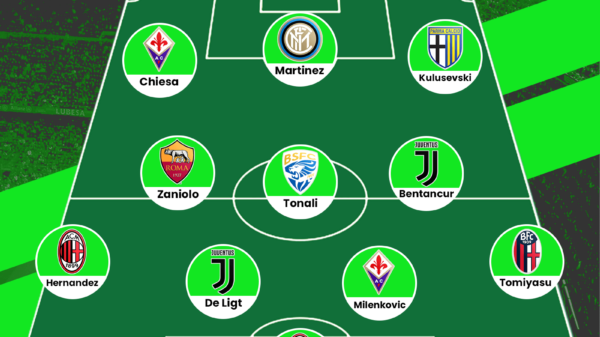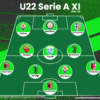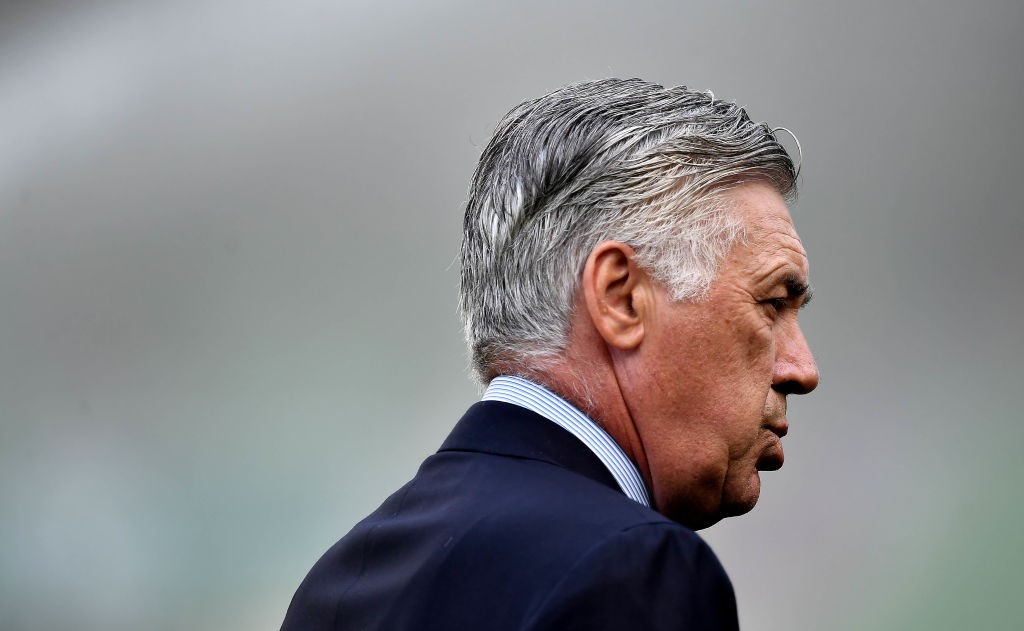Cheuk Hei Ho writes a detailed tactical analysis about the Serie A match that ended Juventus 2-1 Napoli.
Serie A leaders Juventus hosted Napoli in this highly anticipated encounter. It was the first time Gonzalo Higuain played against his former team since his controversial transfer to Turin this summer. He scored the winning goal, and Juventus beat Napoli 2-1.
Massimiliano Allegri’s side fielded a 3-5-2 formation. Because a win in the UCL encounter with Lyon will seal the qualification, Juventus rested Dani Alves, Claudio Marchisio, and Juan Cuadrado and replaced them with Andrea Barzagli, Hernanes, and Stephan Lichtsteiner.
Napoli fielded a 4-3-3 formation with Dries Mertens replacing the suspended Manolo Gabbiadini. Maurizio Sarri made two changes that aimed to add defensive solidity to his side: Vlad Chiriches was picked ahead of Nikola Maksimovic because he is familiar with Higuain’s movement. Amadou Diawara was chosen over Jorginho to add physicality in the midfield.

Made using TacticalPad
Juventus: 1. Buffon; 15. Barzagli, 19. Bonucci, 3. Chiellini; 26. Lichtsteiner, 6. Khedira, 11. Hernanes, 5. Pjanic, 12. Sandro; 17. Mandzukic, 9. Higuain.
Napoli: 25. Reina; 2. Hysaj, 21. Chiriches, 26. Koulibaly, 31. Ghoulam; 5. Allan, 42. Diawara, 17. Hamsik; 7. Callejon, 14. Mertens, 24. Insigne.
Juventus’ tactics
Juventus played with a standard 3-5-2 during the offensive phase. It transformed into a 4-4-2 during the defensive phase, with Barzagli taking the right full-back role while Lichtsteiner played the wide right midfielder.

The 4-4-2 formation usually allows a team to cover the whole field with two lines of defense. It is disadvantageous against a 4-3-3 formation because the three central midfielders in the 4-3-3 have a numerical advantage. Juventus countered such disadvantage with two characteristics of its defensive structure: First, it played a position-oriented zonal marking system, where the whole team shifted according to the ball position. Moreover, Juventus played maintained a rather narrow and compact shape horizontally.

When they shifted to the ball side, it allows them to remove any numerical inferiority against Napoli’s three central midfielders.
In this season Juventus has struggled to settle to a consistent tactic for the initial build-up play during the offensive phase. It is mainly due to two reasons: First, without Marchisio, they do not have a player who can play the central defensive midfielder well enough. Playing in such role requires resistance against being pressed and excellent passing range. Neither Hernanes nor Mario Lemina can do both things well. Secondly, the departure of Pogba and the absence of Marchisio removes any ball holding and dribbling ability in the midfield. Moreover, Miralem Pjanic does not like to hold and dribble the ball (he is averaging 0.4 dribbles/game, ranking him 100th out of 121 all central midfielders in the league). Therefore, the progression of the ball in the midfield relies only on the positional play between the midfielders, making it predictable to the opponent. These issues were further complicated in this game, where they also did not have Cuadrado, Marchisio and the injured Paolo Dybala in the line-up.
In recent matches, Allegri has utilized a simple tactic for Juventus’s build-up play during the offensive phase. Like the classic old school English teams, Juventus primarily delivered long overhead balls to the their wing-backs and the strikers.
Juventus average 67.6 long passes per game in Serie A, ranking them the third most in the league. In this match, they placed 92 long passes!! It took advantage of the physical superiority of Juventus players. For example, the Juventus starters averaged 5cm taller and 7kg heavier than the Napoli’s starters in this game.
Moreover, instead of complicating the offensive phase using their one-dimensional and flawed midfield, Juventus directly delivered the ball to the attacking third. For example, Sami Khedira, Pjanic, and Hernanes only had 18 passes between each other in the whole game. For comparison, Marek Hamsik, Allan, and Diawara had totaled 53 passes between each other. With lesser burden during the build-up, Juventus could use their midfielders (Khedira and Pjanic) as ball receivers for these long balls. Even if they did not directly receive the ball, their mere presence occupied the Napoli’s defenders, freeing their wing-backs.

With Mario Mandzukic lurking behind him, Elseid Hysaj could not stay close with Alex Sandro before the long pass was placed. The presence of Pjanic also occupied Callejon, preventing him from marking Alex Sandro. On the opposite side, Faouzi Ghoulam had to man mark Khedira, making Cuadrado completely unmarked.
Even though their long ball tactics quite successfully delivered the ball to the final third, Juventus’ offense was ineffective in the first half in this match. Their complete lack of ball holding and dribbling did not allow for any changes of speed to a passing sequence. Therefore, the timing of passes and running into space had to be perfect. Moreover, the speed had to be fast enough for the opponent to not respond. Therefore, their offenses were too predictable, and they could not create many genuine scoring opportunities. The situation changed when Cuadrado replaced Giorgio Chiellini at the end of the first half. With his ball-handling skills, Juventus could alter the speed of a passing sequence and penetrate deeper into Napoli’s defense.

Juventus’s passes to the attacking third in the first half.

Juventus’s passes to the attacking third in the first half
Not only were they able to advance the ball deeper in the attacking third, but they were also able to create more chances: Juventus had three shots and seven crosses in the first half while they had seven shots and 20 crosses in the second half.
Napoli’s tactics
With Diawara starting in place of Jorginho, it brought physicality and defensive solidity in the midfield. However, it also interfered with Napoli’s ability to build-up. Diawara’s positioning was not always optimal in this game. He often stayed on a horizontal plane with Hamsik and Allan; such arrangement minimized the passing ranges between them, and therefore, the vertical progression of Napoli’s possession in the midfield.

Compared to Jorginho, Diawara was also inferior regarding off the ball movement to help to create passing lanes for his teammates.

Diawara should not have stayed so close to Hysaj. Moreover, Instead of making a forward movement (the dashed arrow), Diarawa should have moved backward (the solid arrow) to confuse Pjanic, therefore opening a passing lane (blue arrow) between Hysaj and Allan.
Moreover, Napoli’s full-backs did not commit forward to provide enough support during the offensive phase in this game. Therefore, they were not able to stretch Juventus’s defense.

Finally, without a natural striker, Napoli did not have a target ball receiver in the central attacking third. Mertens is too short to play that role. He would not have had the physical strength and size to receive any long ball with the back to protect the ball. If he drops back to the midfield to receive the ball, Napoli will not have any player to occupy Juventus’s central defenders. Therefore, they were not able to deliver the ball to anywhere close to the Juventus’s box area to develop many scoring opportunities.

Conclusion
Juventus showed once again they are a brute force in Serie A. Without any ball dribbler (except Cuadrado), they dragged Napoli into a physical battle. It placed a huge burden on Napoli’s players, who were physically inferior to their opponents. Its effect was evident in the final portion of the match, where Napoli’s players could not respond after Higuain’s goal. Instead of applying pressure to find the equalizing goal, Napoli ended up losing the possession to Juventus, and they finally lost the match. However, it is unclear whether such rudimentary tactic can drag them to beat the European elites in the UCL. For Napoli, there are uncertainties about how they will cope with the absence of Arkadiusz Milik. Their offense looks lost and impotent without him. They will not be able to contend the title without solving this problem.
All stats via fourfourtwo.com and whoscored.com.
Read all our other tactical analyses here

























































